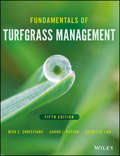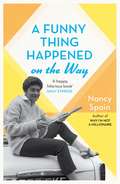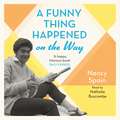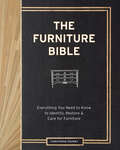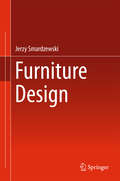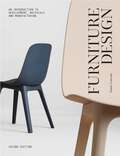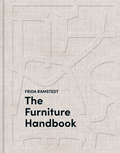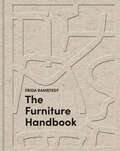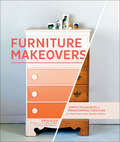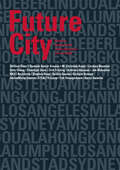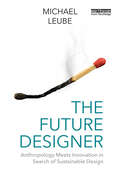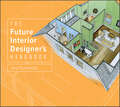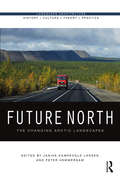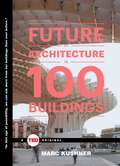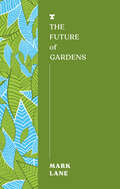- Table View
- List View
Fundamentals of Turfgrass Management
by Nick E. Christians Aaron J. Patton Quincy D. LawThe classic turfgrass management handbook, updated with new developments in the field Fundamentals of Turfgrass Management is the bestselling guide with expert coverage of basic turfgrass science and all aspects of practical care. Now in its fifth edition, this industry favorite offers the latest information on growth, nutrition, herbicides, insecticides, and fungicides, as well as new chapters discussing shade stress and light requirements and the benefits of turf. Though written at an introductory level, this book provides experienced turf managers with the most current thinking and new developments in wide range of topics, such as fertilization, grass selection, pest management, plant growth regulators, sports turf management practices, soil testing, and water quality. For students and experienced professionals alike, this book provides a thorough and well-rounded reference with everyday utility. Today’s turf managers must have detailed knowledge of agronomy, botany, entomology, horticulture, pathology, and business management. This book brings these diverse fundamentals together into a single volume and will help you to: Master the art and science of turfgrass care, cultivation, and management Learn best practices for mowing, fertilizing, soil health, irrigation, and more Identify, manage, and control insect, disease, and weed pests Examine the professional management of sports turf, golf courses, lawns, and sod Turf management is a $70 billion industry that reaches into sports, tourism, land management, real estate, and more. The care and maintenance of high quality turf requires careful consideration and monitoring of many variables, and both strategic planning and quick action are needed to stay ahead of threats from weather, pests, traffic, and more. Fundamentals of Turfgrass Management provides clear guidance and comprehensive coverage of all aspects of the industry, with the latest information all turf managers need to know.
A Funny Thing Happened On The Way: Discover the 1960s trend for buying land on a Greek island and building a house. How hard could it be…?
by Nancy Spain<p>The superb classic memoir from a dazzlingly eccentric and endlessly fascinating author and feminist icon - a woman very much ahead of her time - including her time spent on the glorious island of Skiathos<p> <p>Nancy Spain was one of the most celebrated - and notorious - writers and broadcasters of the 50s and 60s. Witty, controversial and brilliant, she lived openly as a lesbian (sharing a household with her two lovers and their various children) and was frequently litigated against for her newspaper columns - Evelyn Waugh successfully sued her for libel... twice.<p> <p>Nancy Spain had a deep love of the Mediterranean. So it was no surprise when, in the 1960s, she decided to build a place of her own on the Greek island of Skiathos. With an impractical nature surpassed only by her passion for the project, and despite many obstacles, she gloriously succeeded. This classic memoir is infused with all Spain's chaotic brilliance, zest for life and single-minded pursuit of a life worth living.<p>
A Funny Thing Happened On The Way: Discover the 1960s trend for buying land on a Greek island and building a house. How hard could it be…?
by Nancy SpainThe superb classic memoir from a dazzlingly eccentric and endlessly fascinating author and feminist icon - a woman very much ahead of her time - including her time spent on the glorious island of Skiathos'A happy, hilarious book' Daily ExpressNancy Spain was one of the most celebrated - and notorious - writers and broadcasters of the 50s and 60s. Witty, controversial and brilliant, she lived openly as a lesbian (sharing a household with her two lovers and their various children) and was frequently litigated against for her newspaper columns - Evelyn Waugh successfully sued her for libel... twice.Nancy Spain had a deep love of the Mediterranean. So it was no surprise when, in the 1960s, she decided to build a place of her own on the Greek island of Skiathos. With an impractical nature surpassed only by her passion for the project, and despite many obstacles, she gloriously succeeded. This classic memoir is infused with all Spain's chaotic brilliance, zest for life and single-minded pursuit of a life worth living.Perfect for fans of A PLACE IN THE SUN and ESCAPE TO THE COUNTRY'Full of fun, and that zest of intelligence that never left her' Sunday Times
Furnishing Fascism: Modernist Design and Politics in Italy
by Ignacio G. GalánThe role of modernist interior design in the construction of Italian nationalism Along with the rise of Mussolini&’s fascist regime, the interwar years in Italy also saw the widespread development of its modernist interior design and furnishing practices. While the regime&’s politics were overtly manifest in monumental government architecture, Furnishing Fascism examines the subtler yet effective role of household goods and decor in the cultivation of Italy&’s exclusionary sense of national identity. Presenting a fresh look at the work of various architects and designers, including iconic figures such as Gio Ponti and Carlo Enrico Rava, Ignacio G. Galán explores how seemingly neutral products of everyday life contributed to the propagation of fascist ideology. Through extensive promotion in popular magazines and department stores, on the film sets of Cinecittà Studios, and throughout the country&’s colonial territories, Italy&’s modernist design practices were part of a larger political project that aimed to produce a totalizing image of cultural hegemony. Interweaving design theory, architectural history, and media scholarship, Furnishing Fascism reexamines the period&’s so-called minor arts to reveal the political entanglement of modernism in early twentieth-century Italy and offers valuable insight into the complications of cultural production under the auspices of authoritarian power. Retail e-book files for this title are screen-reader friendly with images accompanied by short alt text and/or extended descriptions.
The Furniture Bible: Everything You Need to Know to Identify, Restore & Care for Furniture
by Martha Stewart Jen Renzi Christophe PournyChristophe Pourny learned the art of furniture restoration in his father’s atelier in the South of France. In this, his first book, he teaches readers everything they need to know about the provenance and history of furniture, as well as how to restore, update, and care for their furniture—from antiques to midcentury pieces, family heirlooms or funky flea-market finds. The heart of the book is an overview of Pourny’s favorite techniques—ceruse, vernis anglais,and water gilding, among many others—with full-color step-by-step photographs to ensure that readers can easily replicate each refinishing technique at home. Pourny brings these techniques to life with a chapter devoted to real-world refinishing projects, from a veneered table to an ebonized desk, a gilt frame to a painted northern European hutch. Rounding out this comprehensive guide is care and maintenance information, including how to properly clean leather, polish hardware, fix a broken leg, and replace felt pads, as well as recipes to make your own wax, shellac, varnish, stain, and more.
Furniture Design: An Introduction To Development, Materials And Manufacturing
by Stuart LawsonFurniture Design is a comprehensive guide and resource for students and furniture designers. As well as discussing pioneering contemporary and historical designs, it also provides substantive answers to designers’ questions about function, materials, manufacture and sustainability, integrating guidance on all of these subjects – particularly material and manufacturing properties, in one accessible and structured volume. Many leading contemporary furniture designers from around the world are included, with case studies carefully selected to highlight the importance of both material and manufacture-led design processes. The book is also intended to provide an insight into furniture design for those considering a university education in product and industrial design.
Furniture Design: An Introduction to Development, Materials, Manufacturing
by Stuart LawsonFurniture Design is a comprehensive guide and resource for students and furniture designers. As well as discussing pioneering contemporary and historical designs, it also provides substantive answers to designers’ questions about function, materials, manufacture and sustainability, integrating guidance on all of these subjects – particularly material and manufacturing properties, in one accessible and structured volume. Many leading contemporary furniture designers from around the world are included, with case studies carefully selected to highlight the importance of both material and manufacture-led design processes. The book is also intended to provide an insight into furniture design for those considering a university education in product and industrial design.
Furniture Design
by Jim PostellThe comprehensive guide to furniture design— expanded and updated Furniture designers draw on a range of knowledge and disciplines to create their work. From history to theory to technology, Furniture Design offers a comprehensive survey of the essential craft- and practice-related aspects of furniture design. Generously illustrated with photographs and drawings—including a new color section—this Second Edition features updated coverage of material specifications, green design, digital design, and fabrication technologies. It also features twenty-five case studies of furniture design that represent a broad selection of works, designers, and techniques, including recent designs produced within the last decade. The book explores: Furniture function and social use Form, spatial organization, and typological orders Structural integrity and composition Accessibility, universal design, human factors, and ergonomics The design process, from schematics through fabrication Materials, processes, and methods of fabrication Professional practice and marketing The history of furniture design, from prehistory to the digital age Complete with a glossary of terms and a comprehensive bibliography, Furniture Design, Second Edition is a one-stop resource that furniture designers will turn to regularly for the advice, guidance, and information needed to perform their craft.
Furniture Design
by Jerzy SmardzewskiMaximizing reader insights into the principles of designing furniture as wooden structures, this book discusses issues related to the history of furniture structures, their classification and characteristics, ergonomic approaches to anthropometric requirements and safety of use. It presents key methods and highlights common errors in designing the characteristics of the materials, components, joints and structures, as well as looking at the challenges regarding developing associated design documentation. Including analysis of how designers may go about calculating the stiffness and endurance of parts, joints and whole structures, the book analyzes questions regarding the loss of furniture stability and the resulting threats to health of the user, putting forward a concept of furniture design as an engineering processes. Creating an attractive, functional, ergonomic and safe piece of furniture is not only the fruit of the work of individual architects and artists, but requires an effort of many people working in interdisciplinary teams, this book is designed to add important knowledge to the literature for engineer approaches in furniture design.
Furniture Design, second edition: An Introduction to Development, Materials and Manufacturing
by Stuart LawsonA unique and comprehensive resource for student and professional furniture designers, providing in-depth answers to their questions about aesthetics, function, materials, manufacturing and sustainability. In this second edition Stuart Lawson emphasizes the principles of a circular economy and what this means for furnituredesign and consumption. He considers the latest technological developments such as 3-D printing and the use of innovative materials such as bioplastics. He also examines the capabilities and potential of CAD-based design optimization, AI and machine learning-driven generative design processes.The book features case studies on pioneering, contemporary and historical designers and includes an illustrated directory of materials and manufacturing processes.
Furniture Design, second edition: An Introduction to Development, Materials and Manufacturing
by Stuart LawsonA unique and comprehensive resource for student and professional furniture designers, providing in-depth answers to their questions about aesthetics, function, materials, manufacturing and sustainability. In this second edition Stuart Lawson emphasizes the principles of a circular economy and what this means for furnituredesign and consumption. He considers the latest technological developments such as 3-D printing and the use of innovative materials such as bioplastics. He also examines the capabilities and potential of CAD-based design optimization, AI and machine learning-driven generative design processes.The book features case studies on pioneering, contemporary and historical designers and includes an illustrated directory of materials and manufacturing processes.
Furniture for Interior Design
by Drew PlunkettThis comprehensive, practical guide explores how contemporary furniture is used within interior design to define a space, create division and enclosure, and alter or redefine circulation. Initial chapters illustrate the different contexts in which furniture is used, from the office and domestic interiors to retail and exhibition space; look at types of furniture, whether off-the-shelf or bespoke; and explore the new vogue for recycling and vintage. Later chapters examine both traditional materials such as wood and the more unusual such as stone and glass, while also explaining new methods of manufacture – such as Computer Numerical Controlled and Selected Laser Sintering. The final chapter looks at how a design is developed, the site surveyed, prototypes made and specifications and schedules drawn up.Furniture for Interior Design is a detailed, highly illustrated guide to specifying and placing existing manufactured furniture, but also shows the reader how to design, detail, and commission batch-produced furniture or one-off, site-specific pieces.
Furniture for Interior Design
by Drew Plunkett Sam BoothThis comprehensive, practical guide explores how contemporary furniture is used within interior design to define a space, create division and enclosure, and alter or redefine circulation. Initial chapters illustrate the different contexts in which furniture is used, from the office and domestic interiors to retail and exhibition space; look at types of furniture, whether off-the-shelf or bespoke; and explore the new vogue for recycling and vintage. Later chapters examine both traditional materials such as wood and the more unusual such as stone and glass, while also explaining new methods of manufacture – such as Computer Numerical Controlled and Selected Laser Sintering. The final chapter looks at how a design is developed, the site surveyed, prototypes made and specifications and schedules drawn up.Furniture for Interior Design is a detailed, highly illustrated guide to specifying and placing existing manufactured furniture, but also shows the reader how to design, detail, and commission batch-produced furniture or one-off, site-specific pieces.
The Furniture Handbook: A Guide to Choosing, Arranging, and Caring for the Objects in Your Home
by Frida RamstedtThe comprehensive guide to living with furniture, no matter your style, from the author of The Interior Design Handbook. Interior-design sensation Frida Ramstedt changed how we think about designing a harmonious home with her book The Interior Design Handbook. Now she brings that same authoritative and comprehensive focus to this complementary guide that&’s all about the most essential and functional items within your home. No matter your style of home, we all want our spaces to feel inviting and comfortable. And the key to that is quality furniture that supports your lifestyle. The Furniture Handbook shares the foundational rules of choosing, arranging, and caring for the furniture in every room of your home. From selecting the perfect size dining table and seating that fits your family to arranging your living room pieces for the best flow, the basic principles that interior designers use and that everyone should master are provided.• Know what to pay extra attention to when choosing and rearranging furniture and what common complaints people have so you can avoid them.• Understand the dimensions and details of furniture design that determine whether a piece is comfortable or not.• Select quality upholstery that looks beautiful and will endure wear and tear from pets, kids, and daily life.• Learn how to match the scale of different pieces and plan what goes where before you start moving your furniture, so you never regret the time and money you have invested. Complete with simple and elegant illustrations, The Furniture Handbook is your key to creating beautiful, personal spaces in your home.
The Furniture Handbook: A Guide to Choosing, Arranging, and Caring for the Objects in Your Home
by Frida RamstedtThe comprehensive guide to living with furniture, no matter your style, from the author of The Interior Design Handbook.Interior-design sensation Frida Ramstedt changed how we think about designing a harmonious home with her book The Interior Design Handbook. Now she brings that same authoritative and comprehensive focus to this complementary guide that&’s all about the most essential and functional items within your home.No matter your style of home, we all want our spaces to feel inviting and comfortable. And the key to that is quality furniture that supports your lifestyle. The Furniture Handbook shares the foundational rules of choosing, arranging, and caring for the furniture in every room of your home. From selecting the perfect size dining table and seating that fits your family to arranging your living room pieces for the best flow, the basic principles that interior designers use and that everyone should master are provided.Know what to pay extra attention to when choosing and rearranging furniture and what common complaints people have so you can avoid them.Maximize form and function for the pieces in your home, so you have furniture that is practical, beautiful, and cohesive. Choose the right scale and materials for your space, regardless of how big or small.Understand the dimensions and details of furniture design that determine whether a piece is comfortable or not.Select quality upholstery that looks beautiful and will endure wear and tear from pets, kids, and daily life.Make better choices for every room in your home and create the space you want to live inComplete with simple and elegant illustrations, The Furniture Handbook is your key to creating beautiful, personal spaces in your home.
Furniture Makeovers: Simple Techniques for Transforming Furniture with Paint, Stains, Paper, Stencils, and More
by Barb BlairTransform tired furniture into stunning showpieces: “A fabulous how-to volume for everything from sanding to decoupage and beyond.” —The City Sage blogYou’ll never look at a hand-me-down dresser the same way again! This book offers twenty-six easy-to-follow techniques that can be applied to all different types of pieces, from bookshelves to desks: painting, applying gold leaf, wallpapering, distressing, dip dyeing, and more. In addition to the core techniques, author and Knack Studios founder Barb Blair shares thirty beautiful before-and-after makeovers from her studio and outlines how to achieve each look. With helpful step-by-step photographs, a visual glossary explaining all the tools and materials needed, and a lovely contemporary aesthetic, Furniture Makeovers is a treasure trove of ideas and instruction for the home decorator.“Her amply illustrated book shows why her repurposed furniture is in demand.” —Publishers Weekly
Furniture Makes the Room: Create Special Pieces to Style a Home You Love
by Barb BlairFifteen before-and-after furniture projects to create statement pieces—and tips on how to build a room around them: “As useful as it is beautiful.” —Justina Blakeney, New York Times–bestselling author of JungalowKnack Studio founder Barb Blair is famous for her knack with furniture—spotting classic pieces and transforming them into modern showstoppers. In this inspiring book, Blair goes beyond the nuts and bolts of furniture refinishing to show how to style rooms with each customized piece. For instance, she transforms a well-worn coffee table with a painted ombré design, and then reveals how to incorporate it into a bright and sunny den, a cozy reading nook, and a cheerful bedroom. With instructions for fifteen before-and-after furniture projects—dressers, tables, beds, armoire, and more—in Blair’s signature bold style, a “toolbox” section detailing her favorite techniques and materials, and photos of dozens of inspiring interiors, Furniture Makes the Room unlocks the secrets to decorating livable rooms around statement pieces.
Future City
by Stephen Read Jürgen Job Van EldijkThis text focuses on cities as the dominant form of human settlement for the future, examining the transformation that is happening in urban connobations worldwide today. The last few decades have seen a rate of change and growth in cities that has never been seen before, resulting in giant metropoles with over twenty million inhabitants. This book tackles the causes of these changes, and looks at how the planning and design of cities can shape the urban future.
The Future Designer: Anthropology Meets Innovation in Search of Sustainable Design
by Michael LeubeDuring periods of environmental and societal upheaval, design has the potential to be a formidable catalyst towards a sustainable future. However, to unleash its full power, significant shifts in both theory and practice are imperative. This book adopts a unique approach, blending anthropological perspectives with philosophy and cognitive science, and advocates for a thorough transformation of the existing design curriculum.Supported by a vast body of literature in evolutionary science and design research, the book presents a blueprint for fostering more sustainable patterns of production and consumption. This blueprint is grounded in human virtues rather than vices and proposes a new curriculum tailored towards pro-sociality and sustainability. Leveraging his extensive professional background and expertise in the circular economy, Michael Leube offers practical examples, methods and tools for implementing sustainable approaches in the practical work of experienced designers. Showcasing cutting-edge innovations for pro-social and humanitarian design, the book ultimately argues that if we change the objective of design from creating desire to creating value, we can solve many of the most pressing social problems, from the cooperation of citizens to sustainable cities.The book will be useful for those studying and teaching design and anthropology, and it will also be an important tool for practicing designers and engineers interested in learning how to design for social and ecological awareness.
A Future for Planning: Taking Responsibility for Twenty-First Century Challenges (RTPI Library Series)
by Michael HarrisAs well as being spatial, planning is necessarily also about the future – and yet time has been relatively neglected in the academic, practice and policy literature on planning. Time, in particular the need for longer-term thinking, is critical to responding effectively to a range of pressing societal challenges from climate change to an ageing population, poor urban health to sustainable economic development. This makes the relative neglect of time not only a matter of theoretical importance but also increasing practical and political significance. A Future for Planning is an accessible, wide-ranging book that considers how planning practice and policy have been constrained by short-termism, as well as by a familiar lack of spatial thinking in policy, in response to major social, economic and environmental challenges. It suggests that failures in planning often represent failures to anticipate and shape the future which go well beyond planning systems and practices; rather our failure to plan for the longer-term relates to wider issues in policy-making and governance. This book traces the rise and fall of long-term planning over the past 80 years or so, but also sets out how planning can take responsibility for twenty-first century challenges. It provides examples of successes and failures of longer-term planning from around the world. In short, the book argues that we need to put time back into planning, and develop forms of planning which serve to promote the sustainability and wellbeing of future generations.
The Future Home is Wise, Not Smart
by Gerhard LeitnerThis book introduces the concept of the wise home. Whilst smart homes focus on automation technologies, forcing users to deal with complex and incomprehensible control and programming procedures, the wise home is different. By going beyond intelligence (or smartness) the wise home puts technology in the background and supports explicit (enhanced user-experience) as well as implicit (artificial intelligence) interaction adequate to the end-user's needs. The theoretical basis of the wise home is explored and examples for its application for future living are presented based on empirical studies and field work carried out by the author. Principles of HCI and the meaning of the home from differing scientific perspective are discussed and a research model (based on the concept of user experience (UX)) and iterations is introduced. This has resulted in field deployment guides being produced through a systematic development process. The Future Home is Wise, not Smart will be essential reading to home system developers, designers and researchers, responsible for smart home deployment or Ambient Assisted Living (AAL) who will get insights on how to follow a novel approach in developing and adapting smart home systems to their users' needs. Students with an interest in software design for pervasive systems will benefit by receiving information on how to develop and customise systems for the specific needs of living environments.
The Future Interior Designer's Handbook
by Jana RosenblattCalling all aspiring interior designers! Get ready to dive into the captivating world of interior design with a book that introduces you to the role, techniques, and skills of interior design. You are invited to follow Taylor, a talented interior designer, as she transforms the unfinished attic of her home into a stunning living space. Step by step, readers will learn the ins and outs of the design process, gaining invaluable knowledge along the way. Unleash your creativity as you explore the three main drawings used by interior designers: the floor plan, section, and elevation. Discover the art of drawing to scale, enabling you to accurately represent your vision on paper. From initial planning to the final touches, this book guides you through each stage, teaching essential design techniques, basic color theory, mood board creation, and the architectural styles that shape modern interiors. The Future Interior Designer's Handbook is the perfect introduction to the captivating field of interior design. While it caters to the middle grades, ages 8–12, this book's wealth of knowledge and inspiration will resonate with design enthusiasts of all ages, including adults who are eager to explore their creative potential.
Future North: The Changing Arctic Landscapes (Landscape Architecture: History - Culture - Theory - Practice)
by Janike Kampevold Larsen Peter HemmersamThe changing Arctic is of broad political concern and is being studied across many fields. This book investigates ongoing changes in the Arctic from a landscape perspective. It examines settlements and territories of the Barents Sea Coast, Northern Norway, the Russian Kola Peninsula, Svalbard and Greenland from an interdisciplinary, design-based and future-oriented perspective. The Future North project has travelled Arctic regions since 2012, mapped landscapes and settlements, documented stories and practices, and discussed possible futures with local actors. Reflecting the multidisciplinary nature of the project, the authors in this book look at political and economic strategies, urban development, land use strategies and local initiatives in specific locations that are subject to different forces of change. This book explores current material conditions in the Arctic as effects of industrial and political agency and social initiatives. It provides a combined view on the built environment and urbanism, as well as the cultural and material landscapes of the Arctic. The chapters move beyond single-disciplinary perspectives on the Arctic, and engage with futures, cultural landscapes and communities in ways that build on both architectural and ethnographic participatory methods.
The Future of Architecture in 100 Buildings (TED Books)
by Marc KushnerThe founder of Architizer.com and practicing architect draws on his unique position at the crossroads of architecture and social media to highlight 100 important buildings that embody the future of architecture.We’re asking more of architecture than ever before; the response will define our future. A pavilion made from paper. A building that eats smog. An inflatable concert hall. A research lab that can walk through snow. We’re entering a new age in architecture—one where we expect our buildings to deliver far more than just shelter. We want buildings that inspire us while helping the environment; buildings that delight our senses while serving the needs of a community; buildings made possible both by new technology and repurposed materials. Like an architectural cabinet of wonders, this book collects the most innovative buildings of today and tomorrow. The buildings hail from all seven continents (to say nothing of other planets), offering a truly global perspective on what lies ahead. Each page captures the soaring confidence, the thoughtful intelligence, the space-age wonder, and at times the sheer whimsy of the world’s most inspired buildings—and the questions they provoke: Can a building breathe? Can a skyscraper be built in a day? Can we 3D-print a house? Can we live on the moon? Filled with gorgeous imagery and witty insight, this book is an essential and delightful guide to the future being built around us—a future that matters more, and to more of us, than ever.
The Future of Gardens (The FUTURES Series)
by Mark LaneA bold new look at the changes confronting gardening — including climate change and AI — by acclaimed horticulturalist, TV host, and disabilities activist Mark Lane . . . .Gardening is about choices. Which plants to choose for your soil type and conditions? Where to place them to maximise their growth? What to feed them, and when to water them? And how can all of this be done in a sustainable way? In The Future of Gardens, broadcaster and designer Mark Lane examines present-day considerations alongside those gardeners will need to make in the future.As Earth heats up and populations soar, water will become scarcer on many parts of the planet, and efficient management of it will be key: drought-tolerant planting and smart irrigation systems will likely become commonplace, as will vertical and otherwise space-restricted gardening. And as our world faces stressed or collapsing ecosystems, gardens will be crucial in improving wildlife populations – but only if we let them.Tech will play its part, too. AI-powered apps already provide tips to the green-fingered, but its dominance is a concern. How might we find a happy coexistence? Lane also imagines the potential for gardening in space: what challenges will interstellar travellers face as they cultivate plants on spacecrafts, or even on distant worlds?The Future of Gardens looks at this evergreen discipline with a bold, vibrant and inquisitive eye. Lane&’s own vision for inclusivity, sustainable practice and forward-looking design shines throughout this extraordinary addition to the FUTURES series.
